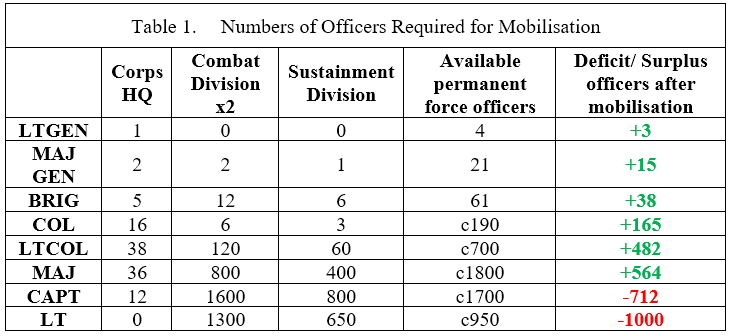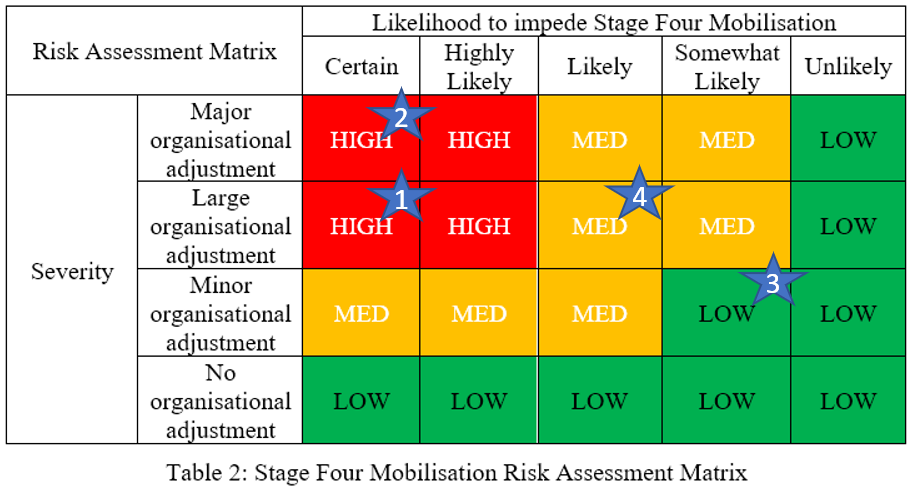Note: This article is a summary of a research thesis conducted at the Command and General Staff College, Army University, United States of America. The research thesis was titled “GOING ALL IN: Stage Four Mobilization in The Australian Army and the Enduring Issues Related to Sustaining Professional Military Leadership”. This thesis is available here.
Introduction
Have you ever been sitting at home watching the war in Ukraine or listening to people at work talk about growing great power competition, the threat of large-scale combat, and wondered how might the Australian Army respond if we were faced with this challenge? If you have – good; if you haven’t – you’re probably like most others but might want to start considering it.
As military professionals it behoves us to consider the highest risk outcomes in any situation and have considered the issues and mitigations. It was these musings that led me to conduct a research thesis into Stage Four Mobilisation in the Australian Army whilst posted to the United States Army Command and General Staff College. Stage Four Mobilisation is what the Australian Defence Force describes as profound increases in capability to meet national objectives. Basically, it means expanding the services beyond their current force structure.
In this short article I will discuss my research and explain why we should understand the enduring issues associated with mobilising the Australian Army beyond its current force structure. This is especially pertinent when we consider the issues with providing our mobilised forces with quality officers for leadership. I will briefly explain the outcomes of the research, some background, and conclude by explaining the relevance to contemporary actions by the Australian Army.
Outcomes of the Research
The aim of the research was to understand the enduring issues confronted by the Australian Army when it mobilises beyond its current force structure; in particular, its impact on the provision of officers for leadership. After nearly ten months of research and writing I concluded that there were four enduring issues confronting the Australian Army. They were:
- Enduring Issue 1: A lack of mobilisation doctrine increases the time taken to mobilise and generates friction internal to the Army.
- Enduring Issue 2: The difficulties associated with developing new junior officers and non-commissioned officers (facilities and timelines) will severely impede the Army’s ability to sustain professional military leadership into, and within, mobilised units.
- Enduring Issue 3: There is no defined time for how long it takes to provide tacit experiences to develop professional military leadership for mobilised units.
- Enduring Issue 4: The Army is slow to recognise the potential of civilian skills to supplement professional military leadership within the permanent or reserve components of the force.
What makes these issues enduring is that they were present during WW1 and WW2 (the last times we entered Stage Four Mobilisation) and during an analysed future mobilisation event. The primary purpose of this research is to assist the Australian Defence Force, and specifically the Australian Army, in understanding where it is carrying risk into the future when considering mobilisation. It is hoped that this research can help inform the work being conducted by the Vice Chief of Defence Force’s (VCDF) Force Design Division as they develop a contemporary mobilisation planning framework across Defence. It will also have utility within Army as it continues to transform its training system.
Research Background
Prior to arriving at the above outcomes, I spent a significant amount of time researching and understanding previous Stage Four Mobilisation events, contemporary views on mobilisation, and leadership and knowledge management theories. The official Australian histories of WWI and WWII were particularly helpful, written by Charles Bean and Gavin Long respectively. For contemporary views on mobilisation in Australia both RAND and Dr Peter Layton’s work were particularly useful. Finally, understanding key leadership and knowledge management theories were critical in linking Army’s desired capabilities with the progression through explicit and tacit learning experiences.
The review of literature allowed me to draw out several key themes and issues that appeared to repeat themselves. These were centred on a lack of doctrine for mobilisation, shortages in junior leaders from the outset of a large-scale war, a very limited understand of training requirements, and a reluctance to make use of civilians in military positions within Australia. To confirm these as genuinely enduring issues though, the research required analysis of a future case study.
The research used a fictional future intelligence scenario to trigger Australia entering a Stage Four Mobilisation event. It was based on ‘The Chinese Civil War’ as described by Douglas Alan Cohn in his book ‘World War Four’. This enabled the thesis to identify and analyse the enduring issues that might confront the Australian Army if it was asked to establish an expeditionary Corps for overseas service. It shouldn’t come as a surprise that our Allies asked for Australia and New Zealand to create an ANZAC Corps for service overseas. The research then used three evaluation criteria to analyse the collected data. The criteria were: 1) Scalability, 2) Doctrine and Training 3) Personnel and Leadership.
Scalability addressed where, and how, the Australian Army could expand beyond its current force structure. During WWI and WWII, the Australian Army used citizen soldiers to fill its bill and largely used militia officers or promotions from within the ranks to fill its officer positions. Table 1 highlights the deficit of junior officers is likely to be repeated under a future mobilisation event. Table 1 also highlights the depth in professional military leadership resident within the Australian Army from MAJ – LTGEN.

Doctrine and Training addressed how publications have supported mobilisation in the past and how useful it would be into the future. Unfortunately, Australian Army doctrine on mobilisation is lacking. Given the focus of the last 20 years has been fighting the Global War on Terror this isn’t surprising but is now something the force can address. Further, the Australian Army’s training system is geared towards meeting peacetime requirements with little consideration (in Army Training Instructions or doctrine) as to how it would expand to meet mobilisation requirements. Furthermore, whilst the Army’s Training Instructions explain what explicit and tacit knowledge / experiences are, it does little to quantify the time differential required between the two.
At the Personnel and Leadership level, the Australian Army is surprisingly well equipped. The depth of senior professional military leadership is testament to this. However, vacancies at the LT-CAPT level will be highly problematic as training effective personnel to fill these gaps will take considerable time. What the research also highlighted is that the Army has no system or concept in place with which it could free up highly trained military officers for overseas service by using similarly trained civilian counterparts. A simple example of this would be using a project management trained civilian to replace a MAJ/LTCOL or COL from a capability role and thus freeing up the officer for military employment overseas.
Following the evaluation of these three criteria, the thesis assessed each enduring issue on the level of risk which it poses towards the Australian Army. Figure 2 visually represents where enduring issues 1 through 4 fall within the risk assessment matrix.

The purpose of assigning risk levels to each enduring issue was to support future action by Defence. In this way, Defence can look to mitigate the highest levels of risk first and simultaneously understand its relevance to contemporary actions.
Relevance to Contemporary Actions
The Australian Army is currently undergoing rapid amounts of change to modernise as great power competition intensifies around us. Areas of significant development are in the VCDF’s Force Design Review for understanding mobilisation and Army’s Future Ready Training System. It is in these areas that this research can contribute to improving our ability to handle a Stage Four Mobilisation event.
Understanding the enduring issues of mobilisation in the Australian Army will place the organisation in a position from which it can solve them. Improving doctrine will help future staff officers understand what they need to do and how to go about it. Quantifying training times for junior officers will illuminate limits on throughput and facilities across the country. Understanding the minimum time for leaders to develop tacit experiences will be essential to building the practical capabilities of the force. Additionally, understanding how the Army might leverage civilian skills to free up professional military leadership and experience will make better use of our human capital.
Mobilisation, at the national level, is incredibly complex. However, as professionals, this means we shouldn’t shy away from trying to understand it and improve our chances of negotiating it. Understanding, and cataloguing, the enduring issues of Stage Four Mobilisation in the Australia Army is just the start.










Well done boss.
A major error identified by Perry was the tendency to over-expand in the early parts of each war, followed by reduction later. While your article suggests that a relatively modest expansion is being looked at, unfortunately, you also need to be conscious of the probability of political pressure to go further, and have arguments prepared to counter that pressure.
On the matter of developing junior leaders, and developing their tacit experiences, the Scheyville experience during the Vietnam period could be worthy of study, as could the training and development of junior NCOs in the same period. Senior Lieutenants should be able to cover some of the gap at Captain level, and Senior NCOs at Lieutenant level.
Late last year (2021) the RAAC Corps RSM explained that ECN 062 Cav Scout is to be discontinued. He went on the state that a single ECN is to be introduced which will cover Cav Scout in both ARES and ARA, ie. Cav scouts in ARES units will be trained to the same standard as those in the ARA so as to enable direct reinforcements from ARES to ARA in time of Defence emergency.
Is it the role of the ARES to 'round out' ARA units?